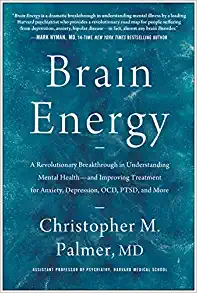Dr. Christopher M. Palmer, a Harvard researcher and psychiatrist, wrote a book called “Brain Energy: A Revolutionary Breakthrough in Understanding Mental Health and Improving Treatment for Anxiety, Depression, OCD, PTSD, and More. Yes, I know, that subtitle is a mouthful. In Brain Energy, Dr. Palmer connects mitochondria dysfunction to mental health issues like Parkinson’s, Alzheimer’s, Dementia, and others. He also makes the connection between Diabetes, Obesity, and general metabolic health issues to mental health issues. This connection leads him to propose both have a common cause. Mitochondrial Dysfunction.

What is Mitochondrial Dysfunction?
Dr. Palmer explains this in his book, but for reference, I’ll use Microsoft’s Bing search bot for answers.
Mitochondrial dysfunction is a condition where the mitochondria do not work as well as they should due to another disease or factor. Mitochondrial dysfunction can reduce the ability of the mitochondria to produce and use energy, which can affect the function of the cells, tissues, and organs that depend on them. Mitochondrial dysfunction can be caused by various factors, such as:
- Genetic mutations in the mitochondrial DNA or the nuclear DNA that affect mitochondrial proteins.
- Environmental toxins that damage the mitochondria or interfere with their function.
- Oxidative stress that overwhelms the antioxidant defense system of the mitochondria.
- Inflammation that triggers the release of cytokines that impair mitochondrial function.
- Aging that leads to the accumulation of mitochondrial damage and decline in mitochondrial quality control mechanisms .
Mitochondrial dysfunction can contribute to many chronic diseases and conditions, such as:
- Diabetes.
- Alzheimer’s disease.
- Parkinson’s disease.
- Cancer.
- Cardiovascular disease.
- Chronic fatigue syndrome.
Source: Conversation with Bing, 6/12/2023
Mitochondrial disease – Wikipedia.
Mitochondrial Diseases: Causes, Symptoms & Treatment – Cleveland Clinic.
Mitochondrial Myopathies | National Institute of Neurological Disorders
Early in the book he describes a story about a man with mental health issues and obesity issues. They first move to tackle the obesity issue and the man engages in a low carb ketogenic diet. His weight improves and he begins to notice he no longer needs the medication he’s on for his mental health issues. The change didn’t happen overnight and it happened totally under the doctor’s care. He was monitored every step of the way. Given his new diet he solved both his problems and became medication free.
Here are some suggestions from the book for improving mitochondrial dysfunction.
- Eating a ketogenic diet, which can help the mitochondria switch from using glucose to using fat as their main fuel source. This can increase the production of ketones, which are molecules that can provide more energy to the brain and protect the mitochondria from oxidative stress.
- Taking certain supplements that can support mitochondrial function, such as coenzyme Q10, alpha-lipoic acid, acetyl-L-carnitine, creatine, and magnesium.
- Avoiding or minimizing toxins that can damage the mitochondria, such as alcohol, tobacco, pesticides, heavy metals, and air pollution.
- Engaging in exercise and intermittent fasting, which can stimulate the growth of new mitochondria and enhance their efficiency.
What are mitochondria?
Again, Dr. Palmer explains this in his book, but for reference, I’ll use Microsoft’s Bing search bot for answers.
Mitochondria are organelles that are found in most eukaryotic cells, such as animals, plants, and fungi. Organelles are structures within a cell that have specific functions. Mitochondria are often called the powerhouses of the cell because they produce most of the energy that the cell needs to function. They do this by using oxygen and converting substances from the food we eat into a molecule called adenosine triphosphate (ATP), which is the main energy currency of the cell.
Mitochondria have a double membrane structure, which means they have two layers of membranes surrounding them. The inner membrane is folded into structures called cristae, which increase the surface area for energy production. The space inside the inner membrane is called the matrix, which contains many enzymes and molecules involved in energy production. The space between the inner and outer membranes is called the intermembrane space, which plays a role in transporting substances across the membranes.
Mitochondria also have their own DNA, which is different from the DNA in the cell nucleus. Mitochondrial DNA (mtDNA) is more similar to bacterial DNA and encodes some of the proteins that are essential for energy production. Mitochondrial DNA is inherited from the mother only, and can be used to trace maternal ancestry.
Source: Conversation with Bing, 6/12/2023
Mitochondria: Form, function, and disease – Medical News Today.
Mitochondrion – Wikipedia.
Mitochondria – National Human Genome Research Institute.


Leave a Reply